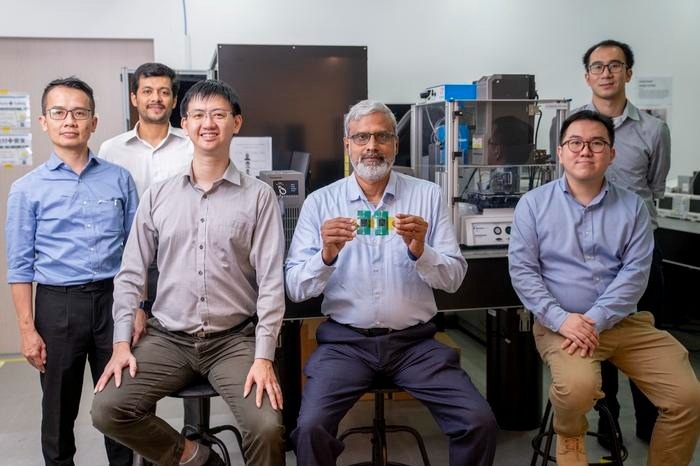A novel multi-material printer has been developed with the use of multi-wavelength high-power lasers for rapid and seamless 3D printing of smart, flexible devices by researchers from Nanyang Technological University, Singapore (NTU Singapore), Panasonic Factory Solutions Asia Pacific Pte. Ltd. (Panasonic), and Singapore Centre for 3D Printing (SC3DP).
 (L-R) Members of the multi-material 3D printer team include Co-leader, Dr Low Mun Ji, General Manager, Panasonic; Dr Suchand Sandeep, Research Fellow, NTU School of Mechanical and Aerospace Engineering (MAE); Dr Nicholas Tham, Senior Research Engineer, Panasonic; Co-leader, Associate Professor Murukeshan Vadakke Matham, NTU School of MAE, Singapore Centre for 3D Printing; Dr Joel Lim, Research Engineer, Panasonic, and Mr Daryl Lim, Research Associate, NTU School of MAE, with the newly developed printer in the background. Assoc Prof Murukeshan is holding onto a sample of a 3D-printed stretchable pressure sensor. Image Credit: Nanyang Technological University
(L-R) Members of the multi-material 3D printer team include Co-leader, Dr Low Mun Ji, General Manager, Panasonic; Dr Suchand Sandeep, Research Fellow, NTU School of Mechanical and Aerospace Engineering (MAE); Dr Nicholas Tham, Senior Research Engineer, Panasonic; Co-leader, Associate Professor Murukeshan Vadakke Matham, NTU School of MAE, Singapore Centre for 3D Printing; Dr Joel Lim, Research Engineer, Panasonic, and Mr Daryl Lim, Research Associate, NTU School of MAE, with the newly developed printer in the background. Assoc Prof Murukeshan is holding onto a sample of a 3D-printed stretchable pressure sensor. Image Credit: Nanyang Technological University
The multi-material printer uses varying wavelengths of laser, making thermal and chemical reactions that can convert common carbon-based materials (polyimide and graphene oxide) into a new kind of highly porous graphene. The consequent structure printed using this new graphene is conductive and light. It can also be coated or printed onto flexible substrates, such as glass, gold, plastics, and fabrics, producing flexible devices.
Traditionally, electronic devices and components have been made of firm materials like silicon, metals, and ceramics, but there exists a growing interest in the production of flexible wearable electronics that could be twisted, bent, and seamlessly conformed to different surfaces.
Our project aims to find a way to 3D print new materials like organic polymers and carbon-based materials like graphene, which has properties that allow them to be printed or coated onto flexible substrates like plastics or fabrics, creating flexible and stretchable circuits. 3D printed flexible electronics paves the way for more comfortable and mobile wearable devices as it can be lighter and smaller. We can now create unique structures that were previously impossible with traditional rigid electronics.
Associate Professor Murukeshan Vadakke Matham, Project Co-Leader, School of Mechanical and Aerospace Engineering, Nanyang Technological University
Murukeshan is also the Principal Investigator at Singapore’s National Additive Manufacturing Innovation Cluster (NAMIC).
3D Printed Sensor for Smart Intravenous Fluid Bag
The recently produced 3D printer has attracted curiosity from companies, including American multinational manufacturer JABIL-MTI Penang.
JABIL-MTI Penang focuses on combining 3D-printed graphene-based electronics with a smart infusion system. A proof-of-concept has been established via a prototype of a cheap intravenous (IV) fluid bag with an embedded printed sensor driven by artificial intelligence. The device tracks the IV drip status, controls parameters such as temperature and pressure flow, and transfers the data to a smartphone in real-time. This facilitates medical personnel to track, regulate, and sense abnormally, remotely, and successfully.
The study group also assessed the likelihood of combining 3D-printed components with the fabrication of high-performing electronics, such as pressure sensors and heaters, with financial support from NAMIC.
We greatly value NTU and Panasonic teams’ creative thinking and innovative approach, and we are excited about the possibilities for future collaborations. We eagerly look forward to exploring further opportunities to work together and leverage both their teams’ exceptional innovation expertise.
Mr Lim Lai Ming, Project Manager, Jabil-MTI Penang
Our technology allows the creation of highly porous and conductive graphene-based material for use in different applications. Compared to traditional graphene manufacturing methods, our method is faster, cheaper, and highly compatible with a wide range of materials.
Dr Low Mun Ji, Project Co-Leader and General Manager, Panasonic
The NTU-Panasonic team hopes that the recently produced 3D printer provides a level of functionality and flexibility unparalleled by other identical products in the market. The project members stated the innovation could revolutionize the field of 3D printing and pave the path to novel possibilities for new product innovation and design.
In 2016, the project between NTU and Panasonic to build the new multi-material printer was launched with the aid of the Singapore Economic Development Board (EDB) in the Industrial Post-graduate Programme (IPP). During that time, the project group has filed two patents, which were presented at 11 international conferences, and published 11 papers. Three Panasonic scientists and engineers, who finished a doctorate from NTU, have been supported.
At the Singapore Centre for 3D Printing (SC3DP) we are investigating the use of additive manufacturing for many applications and industrials sectors, including electronics and wearable devices. Panasonic is a strategic partner, and I am very pleased with the excellent results achieved through this project. This was possible thanks to the hard work of the team of researchers from both SC3DP and Panasonic. The project is a good example of the technical and scientific capabilities available at our center, and how we can support the industry and create value.
Professor Paulo Bartolo, Executive Director, SC3DP
As a next stage, Panasonic has established a new facility at its research hub in Singapore for laser-based manufacturing systems to facilitate more trials of concepts with the use of components made by the multi-material printer, as part of “Autonomous Factory”—a Panasonic concept for the future smart factories. Dr Low and researchers Dr Nicholas Tham and Dr Joel Lim, who were also involved in the joint NTU-Panasonic project, will lead the new facility.